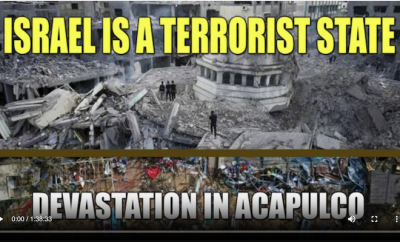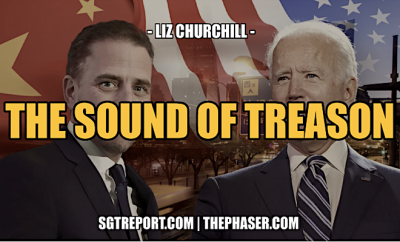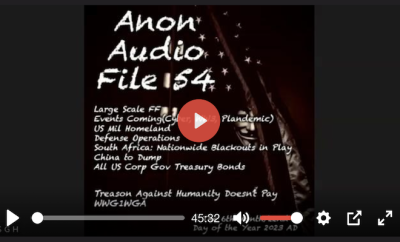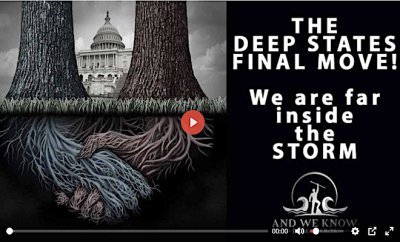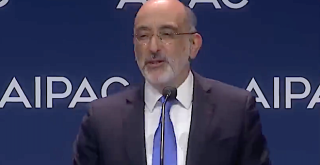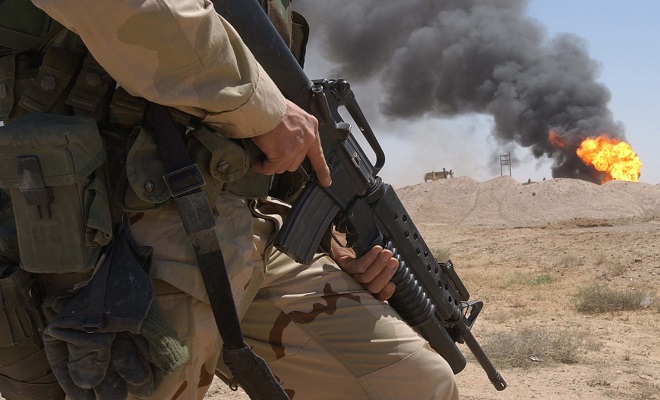 Documentary Den. The oil factor
Documentary Den. The oil factor
Featured
The Petroleum Factor
Wars for Resources?
by John Foster, via CounterPunch.org:
Recent conflicts in Iraq, Libya, Syria, and Ukraine have ostensibly been about “bad guys” who threatened peace with weapons of one kind or another, or stifled freedom and democracy.
Whatever the accusation, concerns about petroleum — oil and gas — are missing from official pronouncements. Yet each of these “hot spots” involves petroleum, a vital commodity for economies worldwide.
Since 9/11, the West has intervened in one country after another. But snapshots of events in each country create a collage with recurring petroleum themes that deserve attention.
Iraq
Iraq has the world’s fifth largest reserves of oil. The Bush administration accused Saddam Hussein of harbouring weapons of mass destruction and being a threat to the world. At the same time, before the invasion, Washington began drafting an oil law for Iraq — one that would open Iraq’s oil to Western companies. During the war, the country’s infrastructure was devastated, thousands of Iraqis were killed, and millions fled as refugees. The Oil Ministry and oil fields were protected. Washington insiders now admit there was an oil agenda.
Although oil was not privatized as Washington envisioned, oil companies thronged to Iraq. The country was poised to become a top oil exporter. Then Islamic State took power in Iraq’s Sunni north and moved to encroach into the Kurdish northeast and Shia south. Each region has huge oil resources. Was recent Western intervention related to petroleum as well as humanitarian concerns?
Libya
In Libya, a country with the world’s ninth largest oil reserves, the limelight was on Muammar Gaddafi. He had used the country’s oil wealth to provide Libyans with free education and healthcare, and to promote pan-African interests, such as the African Union and a new African currency to replace trading in U.S. dollars.
When a rebellion erupted in Libya’s oil region, the West accused Gaddafi of attacks against civilians. The UN authorized a no-fly zone. Under Canadian General Bouchard, NATO flew 9,700 strike sorties, leaving behind death, destruction and chaos. The oil economy was poised to recover until continued violence severely curtailed both exploration and exports. Was Libya a humanitarian intervention, or an excuse for regime change and control of oil? For sure, Gaddafi’s challenges to U.S. hegemony have been eliminated.
Syria
In Syria, the focus has been on Bashar al-Assad and his efforts to quell a civil war. The United States accused him of using chemical weapons against his own people and prepared for war on humanitarian grounds. Russia intervened and Assad agreed to destroy all chemical weapons. Soon, strong evidence emerged questioning U.S. assertions of Assad’s culpability and pointing to the rebels as responsible for the chemical attack. Even so, senior Obama officials still point fingers at Assad.
Coincidence or not, Assad became a foe in 2011, shortly after backing a pipeline proposal to bring gas from Iran — through Iraq and Syria — to Europe. The U.S. supports a rival pipeline proposal to bring gas from Qatar — through Saudi Arabia, Syria and Turkey — to Europe. If one or the other is built, it will be the first pipeline ever to bring gas from the Middle East to Europe. Its sponsors would reap enormous rewards.
The geopolitics are complex. Russia, Iran, and China support the Syrian government. The U.S., France, and Britain support so-called moderate rebels. Saudi Arabia and Qatar bankroll rebels of all sorts, and Turkey provides bases for them. Now, Islamic State is a threat to both the Iran and Qatar pipeline proposals, controlling territory along potential routes.
Ukraine
Formerly part of the Soviet Union, Ukraine is a diverse country. In the west, its populace favours ties to Europe. In the east, the population has close economic, linguistic and cultural ties to Russia. Crimea has a unique status as home to Russia’s Black Sea Fleet since 1783. Before voting to join Russia, it was an autonomous republic within Ukraine.
Two differing narratives obfuscate recent events in Ukraine. The U.S., NATO and European Union have one narrative. It features Vladimir Putin, president of Russia, as the bad guy, accusing him of interfering to create chaos on his border. The Russian narrative highlights U.S. meddling in Ukraine, points to NATO expansion, and openly discusses pipelines.
Russia has the world’s second largest reserves of natural gas. Half of its gas exports flow through Ukraine’s pipelines to Europe. The pipelines matter — for Russia, Ukraine, and Europe. Russia earns half of its foreign exchange earnings from oil and gas. Ukraine receives significant revenue from transit fees on pipelines. Some European countries depend on Russia for all or most of their gas.
Ukraine has become an unreliable transit route, with long-standing payment and delivery issues. To diversify, Russia built Nord Stream, a pipeline bringing Russian gas under the Baltic Sea directly to Germany. With European partners, Russia planned South Stream to bring gas under the Black Sea to Bulgaria and on to central Europe. The European Commission expressed regulatory concerns and in June 2014 intervened to halt construction.
The European Union backs a rival pipeline project, the Southern Gas Corridor, to bring gas from Azerbaijan — through Georgia and Turkey — to Europe. In December 2014, with South Stream stymied, Russia cancelled it and announced Turkish Stream, a project of similar dimension to bring gas across the Black Sea to Turkey for delivery to Europe at the Greek border. Since Turkey does not belong to the European Union, Turkish Stream is unaffected by EU regulations. Now European countries are charged with building their own pipelines to connect at the Greek border.

